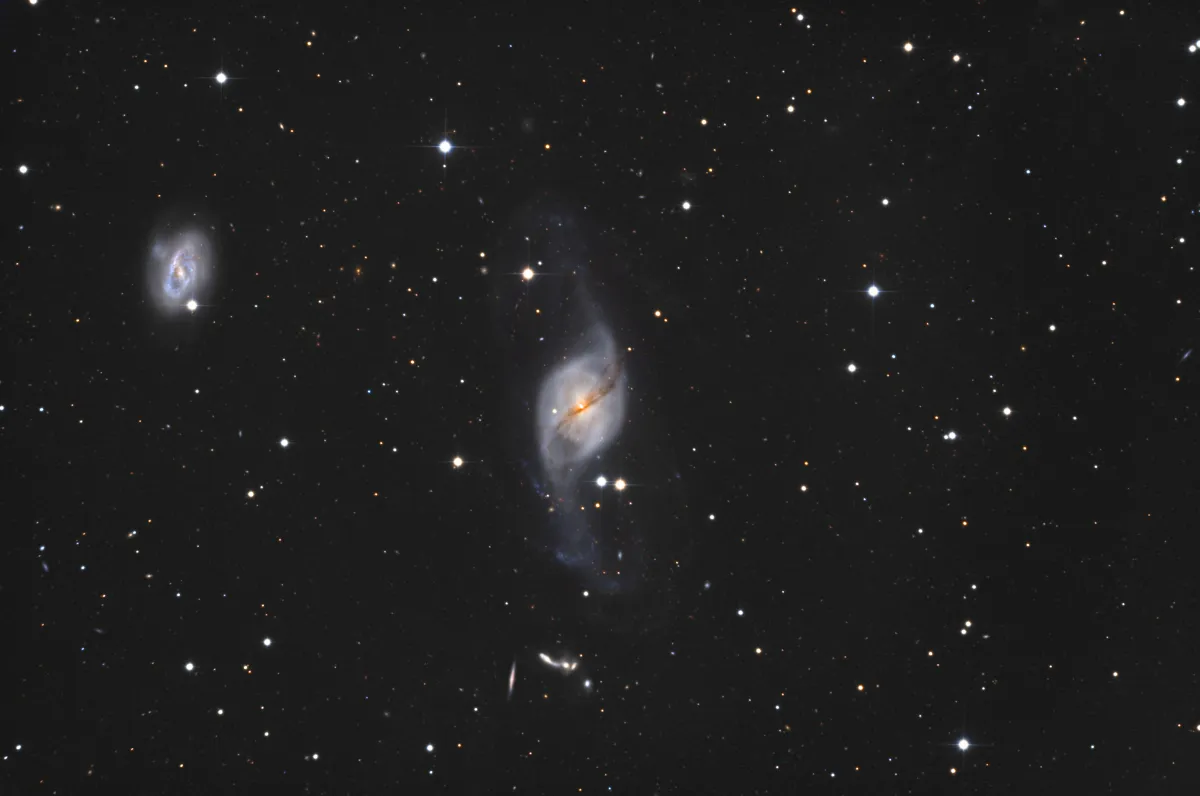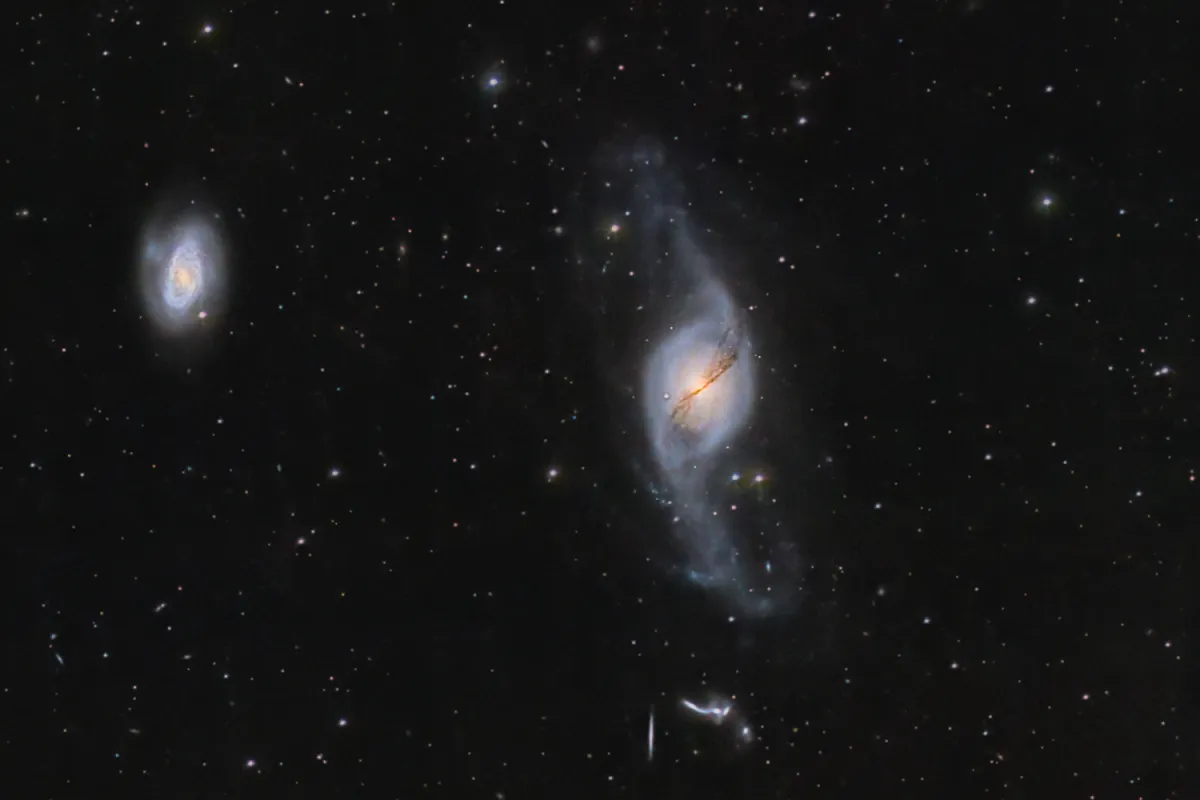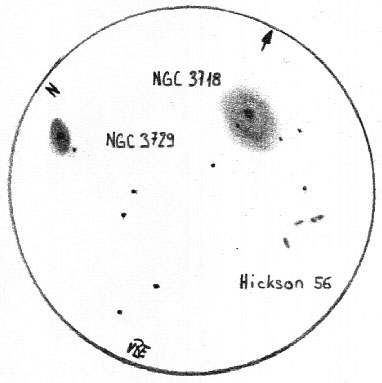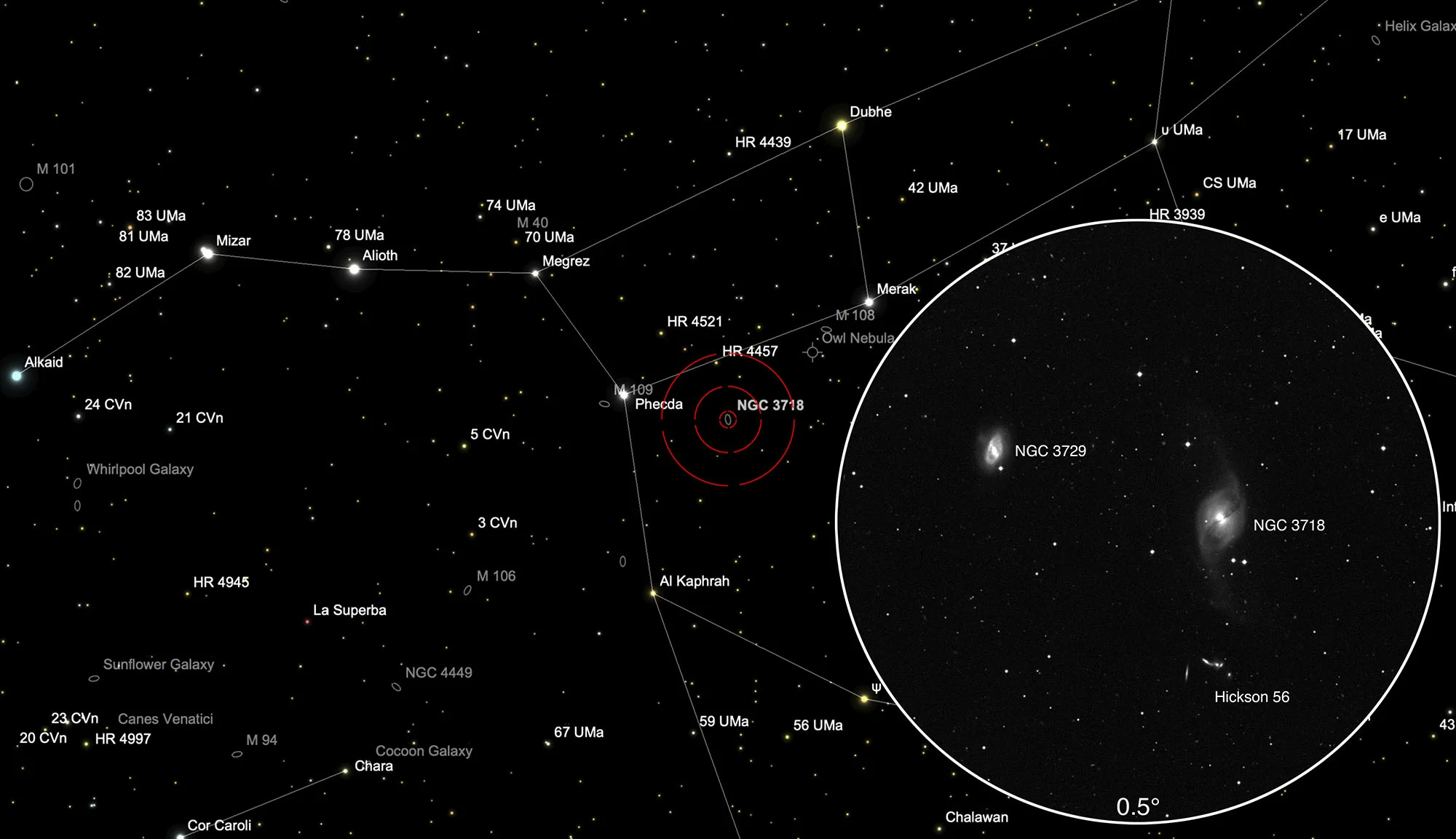Galaxies NGC 3718, NGC 3729 & Hickson 56


History
Both galaxies were discovered on 12 April 1789 by William Herschel using his 18.7 inch reflector. He cataloged them as «bright nebulae» (class I) number 221 and 222. He described I 221 (NGC 3718) as «considerably bright, round, very gradually brighter in the middle, 4 or 5' diameter». About I 222 (NGC 3727) he wrote: «considerably bright, irregular extended near meridian, gradually brighter in the middle, 2' long». [465]
Halton Arp listed NGC 3718 as number 214 in his «Atlas of Peculiar Galaxies» from 1966 as an example of a galaxy with irregularities, absorption and resolution. He wrote: «Barred spiral, sharp nucleus, narrow absorption lanes through centre.» [199]
Physical Properties
The data on the two galaxies are quite extensive and not particularly consistent in places.
For NGC 3718 the NGC says «round». The MCG (Morphological Catalog of Galaxies) has a 3x2.5 arc-minute, bright (class 3) inner part and an 8x2.5 arc-minute, faint (class 5) outer part. The brightness classification is: 1 = brightest, 6 = weakest. Presumably only the inner part of the NGC is described. On the blue POSS, this galaxy even has a size of 11x5 arc minutes. The angle of inclination of the axis of rotation of the galaxy to the line of sight is almost 68 degrees, whereby 90 degrees would mean an edge-on position. The radial speed of this galaxy is just under 1100 km/s. The position angle, i.e. the angle between north and elongation axis, is 15 degrees.
NGC 3729 also has a radial speed of 1100 km/s. Its angle of inclination is 51.3 degrees. The surface brightness is approx. 13 mag; the difference in brightness between the inner (class 1) and outer (class 4) part according to MCG is greater than with 3718. The position angle here is 15 degrees.
| Name | RA | Dec | Type | bMag | vMag | B-V | SB | Dim | PA | z | D(z) | MD | Dreyer Description | Identification, Remarks |
|---|---|---|---|---|---|---|---|---|---|---|---|---|---|---|
| NGC 3718 | 11 32 34.7 | +53 04 02 | Gx (SBa/P) | 11.6 | 10.8 | 0.8 | 14.4 | 8.1 × 4 | 15 | 0.003312 | 13.99 | 17.000 | pB, vL, R, vglbM | WH I 221; h 908; GC 2443; UGC 6524; MCG 9-19-114; CGCG 268-48; IRAS 11298+5320; Arp 214; PRC D-18; KCPG 290A |
| NGC 3729 | 11 33 49.2 | +53 07 35 | Gx (SBa/P) | 12.0 | 11.4 | 0.6 | 13.1 | 2.9 × 1.9 | 165 | 0.003536 | 14.94 | 20.180 | pB, pL, lE 0° ±, gbM, * 12 nr | WH I 222; h 911; GC 2447; UGC 6547; MCG 9-19-117; CGCG 268-51; IRAS 11310+5324; KUG 1131+534; KCPG 290B |
Hickson 56 / Arp 322

Paul Hickson wrote in his «Atlas of Compact Groups of Galaxies» [166]: «Group 56 consists of five galaxies, three of them are apparently in contact and interacting. Two of these three (b and d) are radio sources. Infrared emission is also detected from the interacting system». The mean redshift of the galaxy group is given as 0.0270, which suggests a distance of about 425 million light years.
| PGC | RA | Dec | Type | Dim | Btot | HRV | PA | Names |
|---|---|---|---|---|---|---|---|---|
| PGC 35609 | 11 32 32.7 | +52 56 21 | L M | 16.5 | 7884 | HICK 56E | ||
| PGC 35615 | 11 32 35.3 | +52 56 50 | L M | 16.8 | 8346 | HICK 56D | ||
| PGC 35618 | 11 32 36.7 | +52 56 51 | L M | 15.7 | 8110 | HICK 56C | ||
| PGC 35620 | 11 32 38.8 | +52 56 53 | C M | 1.1 x .3 | 14.8 | 8115 | UGC 6527, MCG 9-19-111, MK 176, (CGCG 268-49), 1ZW 27, VV 150, ARP 322, KUG 1129+532, HICK 56B | |
| PGC 35631 | 11 32 46.6 | +52 56 27 | S M | 1.1 x .2 | 16.0 | 8245 | MCG 9-19-113, (CGCG 268-49), ANON 1129+53E, HICK 56A |
Finder Chart
This delightful pair of galaxies stands south of the Big Dipper's box in the constellation Ursa Maior. You align the telescope with the help of the Telrand and the map below and you should then find the two galaxies without any major problems. The inlet with the section from the DSS helps to identify the faint Hickson 56 group of galaxies.
Visual Observation
200 mm aperture: The galaxies NGC 3718 and NGC 3729 form a pretty pair that can be seen together at a 50 arc-minute field of view. Both galaxies are clearly elongated at 1: 4, whereby the long axes are almost exactly parallel to each other. In addition, the direction of elongation is hardly tilted against the north-south direction. At the southern end of each galaxy there are stars - with NGC 3718 there are two, with NGC 3729, which is a good bit smaller (almost a factor of 1/2), there is one. In photos or in the POSS, these stars are in front of the galaxies, ie. Depending on the telescope aperture, a bit more size and structure can be expected in both galaxies. — 1996, Frank H. Leiter

350 mm aperture: NGC 3718 is the larger of the two NGC objects and shows a bright core and fine outer regions. NGC 3729 has an almost star-shaped core and an elongated elliptical overall shape. Behind the abbreviation Hickson 56 there are actually five galaxies, which one is glad when they are perceived as a group. On closer inspection, the individual galaxies can be seen. — 14" PWO-Dobson, F:4.6 / TV-Radian 8mm, 200x, 0.3°, 2005, Eduard von Bergen
762 mm aperture: The galaxies NGC 3718 and NGC 3729, as well as the galaxy group Hikson 56, could not be more different. The largest of these galaxies is NGC 3718 and shows an elliptical shape and a dark indentation below the core. Galaxy NGC 3729 has an elongated core oriented toward a nearby star. The five visible galaxies of the Hickson 56 group are lined up as 1 2 1, with the «right» one only clearly visible with averted vision. The fifth galaxy lies as a knife edge at right angles to the line of four. — 30" f/3.3 Slipstream Dobsonian, Hasliberg Reuti, 3. 3. 2022, Eduard von Bergen
